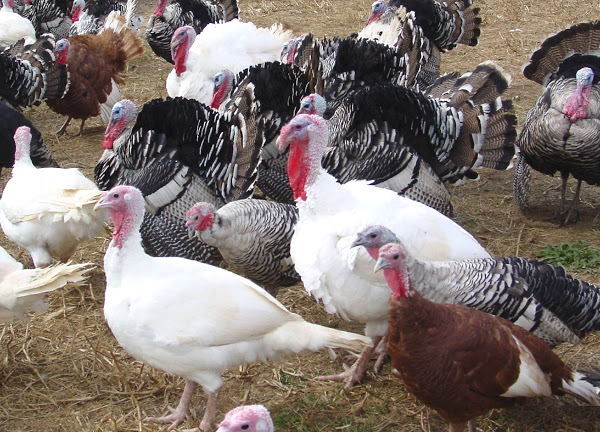Turkey Rearing in Uganda

Turkey meat is one of the widely eaten white meat in Uganda for it contains Vitamin B, Protein, Phosphorous and choline which is nutritious the body. It also keeps insulin levels stable, strengthens the immune system and boosts the body’s defense against cancer. Turkeys are not classified into breeds but they are classified into seven standard varieties: Bronze, White Holland, Bouron red, Narragansett, black slate, Beltsville.
Apart from the health benefits, Turkey rearing can be a great source of earnings if a farmer decides to rear them for commercial benefit. A small (2-4 months old) turkey costs shs 30,000-50,000 while a mature one costs over shs 100000. However, before venturing in a commercial business of selling turkeys, there are some fundamental considerations like demand for products and capital required.
Feeding among Turkeys.
• Just like chicken, Turkeys consume a well formulated ration containing energy feed sources, proteins, fiber, vitamins and minerals.
• Among the energy feed sources, we have brand, brocken maize, brewers waste, millet, sorghum, rice pollard, wheat pollard,
• Proteins fish meal, cotton seed, soya meal, bone meal, blood meal.
• Vitamins are locally harnessed from greens mainly leaves and fruits if accessible. However, Due to inaccessibility during times of demand, a lot of synthetic vitamin supplements are available on the Ugandan veterinary market among which is Nutri- power vitamin, the most known and used by farmers especially in the central region.
• Minerals are mainly synthetic today and added to a ration to make it balanced most of which are called premixes
• Also for turkeys these rations are designed in relation to the growth stage as the newly hatched start on chick and duck or chick mash, after two months the feed is changed to grower’s meal and later after 4-5 months they can continue on growers however the particle size of brocken maize has to be increased.
• The quantities of feed to be given are to be judged by the animal owner in a manner almost similar to the kroiler formula.
Problems associated with rearing Turkeys in Uganda?
A lot of people find it challenging to successfully rear turkeys due to their high death rate. And below are the reasons why Turkey rearing can be challenging;
• Way of life. The domestic turkey’s way of life is sometimes difficult as they retain much instincts of the wild like laying in bushes, aggressive behavior.
• Turkeys also have poor hatchability and do not have the mothering ability to protect their young ones. After hatching the turkey lings are left to fend for themselves and yet some farmers are lazy therefore the little turkey lings get affected by whether leading to death.
Different systems for rearing Turkeys
Turkeys can be reared in three systems .These depend on the farmer’s preference. The rearing systems are free range, backyard and deep little.
Free range
In the free range rearing system turkeys are left to roam freely throughout the whole day and kept inside the house at night. However with this method, they are exposed to a lot of diseases, stray animal attacks especially dogs.
Backyard Farming
This is the type of farming system were the farmer makes a fence in his yard for the turkeys to stay together. In this system the birds have the freedom of movement inside the fence. However it is the role of the owner to avail water, feeds and all the required care.
Deep-litter farming system
This is when a farmer builds a poultry unit for the turkeys, based on the repeated spreading of straw or sawdust material in indoor stalls. An initial layer of litter is spread for the animals to use for bedding material and to defecate in, and as the litter is soiled, new layers of litter are continuously added by the farmer.
Some common Diseases in Turkeys
• One of the most common disease in turkeys is foul (Turkey) pox. It manifests with pox like lesions on the non-feathered areas of the skin like head and legs.
Prevention
• Vaccinate your birds with pox vaccine (This can be done by contacting a veterinary doctor)
• Control movements of animals and humans in your birds. This helps that birds or humans who have been in contact with infected birds do not transfer the virus to your birds. Not everyone should come in contact with your birds.
• NB: Pox Virus has no specific treatment however one can use a strong anti-biotics to prevent advanced side effects.
Coccidiosis
The key signs of coccidiosis in all poultry are the same. They are characterized with yellowish diahorrea for moderate stage, brownish and reddish for severe and acute stages respectively.
Prevention
• Ensure proper hygiene by disinfecting and avoiding dampness of the litter and by providing dip wash so that humans dis infect themselves before coming in contact with the Turkeys.
• Add a coxidiostat to its ration (meal).This can be got from veterinary shops.
Treatment
• Anti coccidial drugs like: Vazurim, Amprolium and sulphur drugs are available in Veterinary shops.
Newcastle
Newcastle manifests itself in three body systems:
• Respiratory rales (sounds) which is spotted by nasal discharges.
• Gastro intestinal tract which manifests with greenish diahorrea
• Nervous system with signs as restlessness, torticollis (twisted necks) and uncoordinated movements. In laying birds, there will be a reduction in egg production
Prevention
• Vaccinate against New Castle
• Improve hygiene
• Control movements of people to and fro in relation to your turkeys.
• Traffic control (control human and other poultry movements in relation to your turkeys.
NB: New castle is a viral disease therefore has no specific treatment. However, trying to manage the symptoms, a farmer should use a strong anti-biotic.







